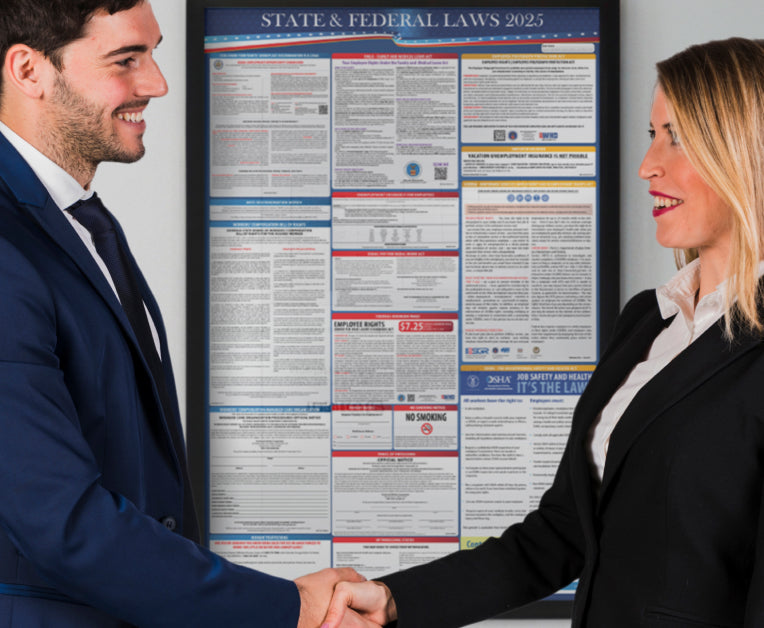
Labor Law Poster Requirements for Educational Institutions
Educational institutions—whether K–12 public and private schools, charter schools, colleges, universities, or trade schools—are subject to many of the same labor and employment regulations as private-sector employers. Though their mission is academic, they also function as employers. As such, they must abide by federal and state laws regarding employee rights, workplace safety, nondiscrimination, leave, and wage standards.
One of the foundational but sometimes overlooked compliance obligations is labor law poster requirements. These posters play a critical role: they inform staff and job applicants of their rights, support transparency, and shield institutions from regulatory penalties.
In this blog, we will explore:
- The specific posters educational institutions must display
- Differences in public vs. private education settings
- Unique considerations for adjuncts, student employees, and academic staff
- Digital posting options in hybrid or remote teaching contexts
- Best practices for poster management and audits
- The risks of noncompliance
- How you can streamline compliance using a professional provider
1. Legal Basis: Why Educational Institutions Must Post Labor Law Notices
Labor law posters are not optional “best practices”—they are legally required. Federal statutes and corresponding regulations demand that certain notices be posted conspicuously in the workplace. The U.S. Department of Labor (DOL) identifies that public agencies (including state and local government employers), public and private elementary and secondary schools, and private sector employers must post workplace notices under many employment laws.

1.1 Federal Laws that Mandate Posters
Some of the key federal statutes requiring posters include:
- Fair Labor Standards Act (FLSA) — minimum wage, overtime, child labor
- Family and Medical Leave Act (FMLA) — rights and responsibilities under leave law
- Occupational Safety and Health Act (OSHA) — “Job Safety & Health: It’s the Law” poster
- Equal Employment Opportunity (EEO) and anti-discrimination notices
- Employee Polygraph Protection Act (EPPA)
- Uniformed Services Employment and Reemployment Rights Act (USERRA)
- Others that may apply depending on institution’s operations (e.g. if it holds federal contracts, it might need posters related to Davis-Bacon, Walsh-Healey, SCA, etc.)
The DOL’s “Posters – Frequently Asked Questions” states that all federal workplace posters must be readable and must be displayed in conspicuous places where employees and applicants can see them.
1.2 State & Local Posters for Educational Settings
In addition to federal notices, each state imposes its own requirements. For educational institutions, this typically includes posters for:
- State minimum wage
- State workers’ compensation
- Unemployment insurance
- State-specific anti-discrimination and harassment laws
- State leave laws (e.g. paid sick leave, family leave, etc.)
- State or local health & safety rules (especially post-COVID or indoor air rules)
- Certification or licensing disclosures, where required in certain states
For example, Illinois requires a “Your Rights Under Illinois Employment Laws” poster covering wage payment, child labor, pay equity, and more.
Universities and colleges often operate across multiple local jurisdictions (campuses in different counties), so poster compliance must align with each locale’s requirements.
1.3 Public vs. Private Educational Institutions
Public educational institutions (state-run schools, community colleges, state universities) are themselves government entities, so federal poster requirements often explicitly apply to them. For private institutions, compliance obligations resemble those of private-sector employers—though many private academe institutions are also subject to collective bargaining or specialized state mandates.
Regardless of ownership, any institution employing staff under federal or state labor, wage, or safety laws must post required notices.
2. Which Posters Should Educational Institutions Display?
Understanding which posters apply is crucial because not every poster is universal. Some requirements depend on the number of employees, the nature of work, or whether the institution holds federal contracts.
Below is a breakdown of common posters that educational institutions likely need.
2.1 Core Federal Posters
Every school or higher education institution should consider posting the following as a baseline:
- FLSA Minimum Wage / Overtime / Child Labor Poster
- FMLA Employee Rights & Responsibilities Poster
- OSHA “Job Safety & Health: It’s the Law” Poster
- EEO / “Equal Employment Opportunity is the Law” Poster
- EPPA (Employee Polygraph Protection Act) Poster
- USERRA Notice
These are considered mandatory for most covered employers.
2.2 Institution-Specific & Conditional Posters
Depending on the institution’s status:
- Federal Contracts / Grants: If your school or university receives federal funding or engages in federally funded construction, you may need Davis-Bacon, Walsh-Healey, Service Contract Act (SCA) posters, etc.
- State Education Compliance: Some states require notices specific to education or teacher rights (e.g., tenure, certification disclosures).
- State Leave & Sick Time: Many states now require notices of paid sick leave or family leave; ensure your institution posts those if applicable.
- Campus Safety / Title IX / Harassment: Institutions often must post sexual harassment, discrimination, Title IX compliance notices, and campus security summaries (e.g., Clery Act) visible to employees and students (though those may have distinct rules).
- Student Employee Notices: Some institutions employ student workers or work-study students — any wage/child labor posters still apply.
Because educational institutions often combine staff, adjuncts, graduate assistants, and student assistants, it’s safer to adopt the broader set of required posters rather than minimal.
2.3 Posting Location Requirements in Educational Settings
Posters should be placed:
- In employee break rooms, staff lounges, HR offices, or faculty mail rooms
- In areas where staff congregate, such as teacher workrooms or copy rooms
- In applicant waiting or interview areas, since some posters must be visible to job applicants
- In multiple buildings on campus—every building that houses employees should have posters
Some DOL guidance clarifies that a combination poster (“six-in-one” or similar) is acceptable if each individual poster meets formatting requirements and remains readable.
3. Challenges Unique to Educational Institutions
Educational institutions face compliance challenges distinct from standard businesses, since their structure, workforce, and operations differ. Here are the key hurdles:
3.1 Multiple Work Sites and Campus Buildings
A university campus might have dozens of buildings, research labs, administrative wings, dormitories, and off-site extension centers. Each building that hosts employees or staff functions should display the required posters. Ignoring “satellite” buildings is a compliance risk.
3.2 Diverse Workforce
Faculty, adjuncts, staff, maintenance personnel, student workers, graduate assistants: each group may work under different rules or under separate contracts. Ensuring that all these categories see the same core notices (e.g. wage laws, discrimination rights) is important to avoid gaps in communication.
3.3 Hybrid or Remote Teaching Staff
Many institutions blend in-person and remote teaching. In these cases, complying with physical posting rules while also offering digital access is essential — which parallels considerations in How Labor Law Posters Differ for Remote and Hybrid Workers. Your compliance approach must cover both modalities.
3.4 Regulatory Oversight in Academia
Institutions often face scrutiny from accrediting bodies, government education departments, unions, faculty associations, and student advocacy groups. A compliance lapse—even a missing poster—can trigger investigations, negative audits, or public relations issues.
3.5 Budget & Administration Complications
Academic budgets may not allocate for compliance tools the way private businesses do. Departments might manage maintenance, compliance, and HR separately, making coordination on poster updates challenging.
4. Digital & Hybrid Posting Options in Education
Because many educational institutions already manage learning management systems (LMS), intranet portals, and email systems, integrating digital poster access is both viable and beneficial.
4.1 When Digital Posting Is Acceptable
The federal DOL allows electronic posting when:
- Employees regularly receive information electronically
- Remote or hybrid work is involved
- The digital medium is accessible to all employees
- Updates are timely
However, digital distribution doesn’t always fully replace physical posters if some staff are onsite. Thus, institutions must support both.
4.2 Implementation Strategies for Schools & Universities
- Institutional Intranet or Portal: Create a dedicated “Employee Rights & Notices” section.
- Onboarding Packages: Include PDF posters in new hire packets or orientation material.
- Email Announcements: Send updates every time a poster changes.
- Departmental Share Drives: Post digital files accessible to each department’s staff.
- Mobile Access: Ensure posters are accessible via mobile for adjuncts or staff without desktop access.
You must ensure that digital versions are identical to physical ones in content and are kept current.
5. The Risks of Noncompliance in Educational Settings

Failing to comply with labor law poster requirements is not without consequences. For educational institutions, the stakes include legal, financial, reputational, and operational risks.
5.1 Fines & Penalties
Agencies such as DOL, state labor departments, and OSHA can impose civil fines for missing or outdated posters. While amounts vary, they can escalate rapidly for multiple violations.
5.2 Increased Exposure in Lawsuits & Grievances
Employees (e.g. faculty or staff) may claim they were unaware of rights if posters were absent. In grievance or arbitration settings, lack of visible notices can weaken your defense, making your institution look negligent.
5.3 Accreditation, Oversight & Audit Consequences
Compliance failures in administrative matters can jeopardize accreditation reviews, state education department audits, or funding oversight reviews. A trivial oversight like a missing notice could be flagged in larger reports.
5.4 Morale, Trust & Institutional Culture
Educational environments thrive on trust and transparency. If employees believe the institution doesn’t pay attention to its legal obligations—even something as visible as posters—morale and trust can erode.
5.5 Negative Public Relations
In academia, reputations matter deeply. A compliance lapse publicly disclosed (especially if tied to faculty or staff complaints) can harm institutional prestige and donor confidence.
6. Best Practices for Managing Posters in Educational Institutions
To minimize risk and maintain compliance, institutions should follow disciplined practices.
6.1 Conduct a Comprehensive Audit
- Inventory all buildings and departments
- Determine which posters each area needs
- Check for outdated versions or damaged postings
- Verify digital versions in your intranet, LMS, and HR portals
6.2 Centralize Responsibility
Designate an office (e.g. HR, Compliance, General Counsel) to manage posters. That office should:
- Track updates
- Order replacements
- Confirm display in new or renovated buildings
- Coordinate with campus safety, facilities, and departmental leads
6.3 Schedule Regular Reviews & Updates
Federal and state laws change regularly. Schedule periodic reviews (at least annually or quarterly) to:
- Compare your posters to updated government versions
- Replace or refresh faded/damaged posters
- Push updated digital versions
6.4 Maintain Documentation & Proof
- Take timestamped photos of posted notices
- Archive change logs, invoice receipts, version change lists
- Keep records of employee acknowledgement, especially for digital distribution
This documentation can protect the institution in audits or legal proceedings.
6.5 Use Professional, Updated Sets
Rather than rely on piecemeal downloads, consider procuring professional compliance poster sets. These sets are prepackaged with both federal and state notices and often come with update services.
For a reliable solution, check out the Labor Law Posters collection. With automatic updates and compliance assurance, institutions can eliminate uncertainty and maintain continuity.
Labor law posters are often dismissed as administrative detail—something to tack on a wall and forget. But for educational institutions, they are a critical link in the chain of transparency, compliance, and institutional integrity.


